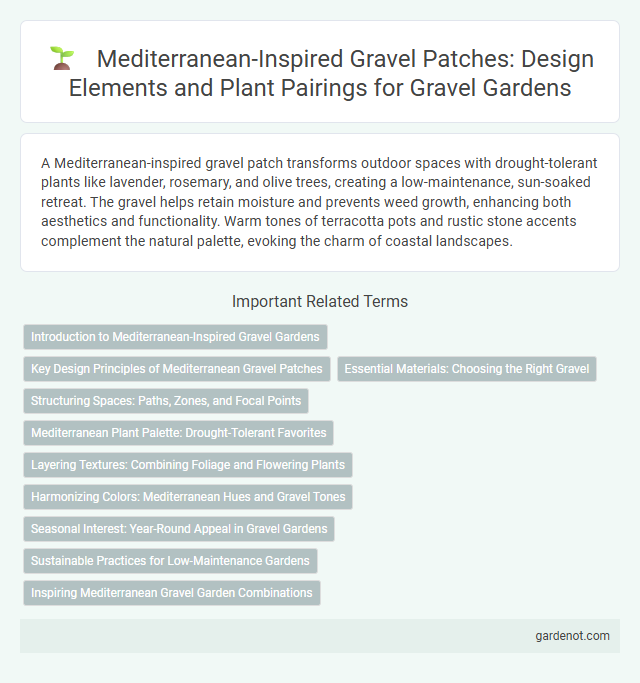A Mediterranean-inspired gravel patch transforms outdoor spaces with drought-tolerant plants like lavender, rosemary, and olive trees, creating a low-maintenance, sun-soaked retreat. The gravel helps retain moisture and prevents weed growth, enhancing both aesthetics and functionality. Warm tones of terracotta pots and rustic stone accents complement the natural palette, evoking the charm of coastal landscapes.
Introduction to Mediterranean-Inspired Gravel Gardens
Mediterranean-inspired gravel gardens emphasize drought-tolerant plants such as lavender, rosemary, and olive trees, thriving in well-drained, sandy soils. These gardens often incorporate sun-baked stones, terracotta pots, and textured gravel to replicate arid landscapes. The combination of aromatic herbs and gravel mulch conserves moisture while creating a low-maintenance, climate-resilient outdoor space.
Key Design Principles of Mediterranean Gravel Patches
Mediterranean-inspired gravel patches prioritize drought-tolerant plant species such as lavender, rosemary, and olive trees, which thrive in well-drained, nutrient-poor soils. These designs incorporate natural stone materials like terracotta pots and sun-baked bricks to enhance texture and warmth while emphasizing simplicity and low maintenance. Strategic layering and asymmetrical planting create a relaxed, sun-soaked ambiance that reflects traditional Mediterranean landscapes.
Essential Materials: Choosing the Right Gravel
Selecting the right gravel is crucial for a Mediterranean-inspired gravel garden, with options like pea gravel, limestone, and decomposed granite providing ideal texture and color. These materials enhance drainage, prevent weeds, and reflect the warm, sun-soaked aesthetic characteristic of Mediterranean landscapes. Choosing gravel that complements native drought-tolerant plants such as lavender and rosemary ensures both functionality and visual harmony in the garden design.
Structuring Spaces: Paths, Zones, and Focal Points
Mediterranean-inspired gravel gardens create structured outdoor spaces by defining paths with smooth, compacted gravel for easy navigation and outlining distinct zones for seating, planting, and relaxation. Incorporating focal points such as terracotta pots, olive trees, or stone benches enhances visual interest and guides movement throughout the garden. This design approach optimizes space efficiency while emphasizing natural textures and warm, earthy tones characteristic of Mediterranean landscapes.
Mediterranean Plant Palette: Drought-Tolerant Favorites
Mediterranean-inspired gravel gardens showcase drought-tolerant favorites such as lavender, rosemary, and thyme, all thriving in well-drained, sun-drenched conditions. These plants reduce water usage while enhancing soil stability and adding fragrant greenery to gravel patches. Incorporating olive trees and succulents further enriches the garden's texture and resilience against arid climates.
Layering Textures: Combining Foliage and Flowering Plants
Mediterranean-inspired gravel gardens thrive by layering textures through a mix of silvery-leaved lavender, aromatic rosemary, and vibrant flowering pelargoniums. This combination creates visual interest and enhances drought tolerance by pairing sun-loving shrubs with resilient perennial blooms. Incorporating varying plant heights and leaf shapes further enriches the gravel patch's Mediterranean aesthetic and ecological balance.
Harmonizing Colors: Mediterranean Hues and Gravel Tones
Mediterranean-inspired gravel gardens harmonize colors by blending warm terracotta, ochre, and deep olive greens with natural gravel tones such as sandy beige, soft gray, and muted rust. These color combinations evoke the sun-drenched landscapes of coastal Europe while enhancing texture and depth in the garden design. Incorporating drought-tolerant plants like lavender, rosemary, and olive trees accentuates the authentic Mediterranean palette.
Seasonal Interest: Year-Round Appeal in Gravel Gardens
Mediterranean-inspired gravel gardens showcase year-round appeal by incorporating drought-tolerant plants like lavender, rosemary, and sedum that provide vibrant seasonal interest through varying foliage colors, textures, and blooms. Gravel mulch enhances drainage and reflects heat, supporting plant health across seasons while minimizing maintenance. Strategic placement of ornamental grasses and succulents adds dynamic movement and structure, maintaining visual appeal from spring through winter.
Sustainable Practices for Low-Maintenance Gardens
Mediterranean-inspired gravel gardens utilize drought-tolerant plants like lavender and rosemary to minimize water consumption and promote long-term sustainability. Incorporating permeable gravel surfaces enhances soil drainage and reduces runoff, supporting healthy root systems and conserving water resources. Mulching with natural materials further retains moisture and suppresses weeds, reducing the need for chemical interventions and frequent maintenance.
Inspiring Mediterranean Gravel Garden Combinations
Mediterranean-inspired gravel gardens combine drought-tolerant plants like lavender, rosemary, and olive trees with terracotta pots and natural stone features to create a sun-soaked, low-maintenance outdoor space. Incorporating aromatic herbs and drought-resistant succulents enhances texture and fragrance, while gravel in warm tones such as ochre or terracotta provides excellent drainage and a rustic aesthetic. Integrating wrought iron furniture and mosaic accents further elevates the authentic Mediterranean ambiance in these garden combinations.
Mediterranean-inspired gravel patch Infographic

 gardenot.com
gardenot.com